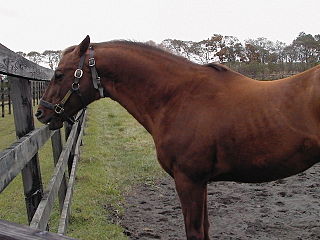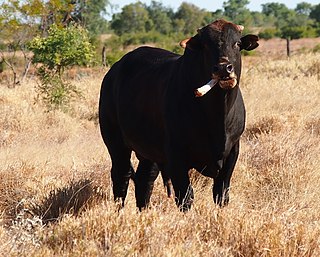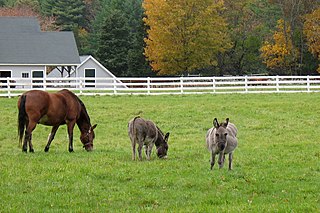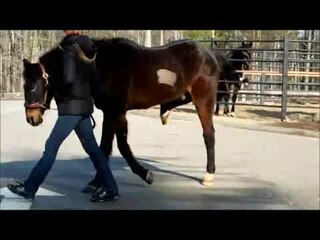
Horse teeth refers to the dentition of equine species, including horses and donkeys. Equines are both heterodontous and diphyodontous, which means that they have teeth in more than one shape, and have two successive sets of teeth, the deciduous and permanent sets.
Colic in horses is defined as abdominal pain, but it is a clinical symptom rather than a diagnosis. The term colic can encompass all forms of gastrointestinal conditions which cause pain as well as other causes of abdominal pain not involving the gastrointestinal tract. What makes it tricky is that different causes can manifest with similar signs of distress in the animal. Recognizing and understanding these signs is pivotal, as timely action can spell the difference between a brief moment of discomfort and a life-threatening situation. The most common forms of colic are gastrointestinal in nature and are most often related to colonic disturbance. There are a variety of different causes of colic, some of which can prove fatal without surgical intervention. Colic surgery is usually an expensive procedure as it is major abdominal surgery, often with intensive aftercare. Among domesticated horses, colic is the leading cause of premature death. The incidence of colic in the general horse population has been estimated between 4 and 10 percent over the course of the average lifespan. Clinical signs of colic generally require treatment by a veterinarian. The conditions that cause colic can become life-threatening in a short period of time.

Flunixin is a nonsteroidal anti-inflammatory drug (NSAID), analgesic, and antipyretic used in horses, cattle and pigs. It is often formulated as the meglumine salt. In the United States, it is regulated by the U.S. Food and Drug Administration (FDA), and may only be lawfully distributed by order of a licensed veterinarian. There are many trade names for the product.

The health of dogs is a well studied area in veterinary medicine.

Carprofen is a nonsteroidal anti-inflammatory drug (NSAID) of the carbazole and propionic acid class that was previously for use in humans and animals but is now only available to veterinarians for prescribing as a supportive treatment for various conditions in animals. Carprofen reduces inflammation by inhibition of COX-1 and COX-2; its specificity for COX-2 varies from species to species. Marketed under many brand names worldwide, carprofen is used as a treatment for inflammation and pain, including joint pain and postoperative pain.
An enterolith is a mineral concretion or calculus formed anywhere in the gastrointestinal system. Enteroliths are uncommon and usually incidental findings but, once found, they require at a minimum watchful waiting. If there is evidence of complications, they must be removed. An enterolith may form around a nidus, a small foreign object such as a seed, pebble, or piece of twine that serves as an irritant. In this respect, an enterolith forms by a process similar to the creation of a pearl. An enterolith is not to be confused with a gastrolith, which helps digestion.
Choke is a condition in horses in which the esophagus is blocked, usually by food material. Although the horse is still able to breathe, it is unable to swallow, and may become severely dehydrated. A secondary condition, aspiration pneumonia, may also develop if food material and saliva accumulate in the pharynx, spilling into the trachea and into the lungs. Choke is one of the "top 10" emergencies received by equine veterinarians.

Cribbing is a form of stereotypy, otherwise known as wind sucking or crib-biting. Cribbing is considered to be an abnormal, compulsive behavior seen in some horses, and is often labelled a stable vice. The major factors that cause cribbing include stress, stable management, genetic and gastrointestinal irritability.
Exercise-induced pulmonary hemorrhage (EIPH), also known as "bleeding" or a "bleeding attack", is the presence of blood in the airways of the lung in association with exercise. EIPH is common in horses undertaking intense exercise, but it has also been reported in human athletes, racing camels and racing greyhounds. Horses that experience EIPH may also be referred to as "bleeders" or as having "broken a blood vessel". In the majority of cases, EIPH is not apparent unless an endoscopic examination of the airways is performed following exercise. This is distinguished from other forms of bleeding from the nostrils, called epistaxis.

Osteophagy is the practice in which animals, usually herbivores, consume bones. Most vegetation around the world lacks sufficient amounts of phosphate. Phosphorus is an essential mineral for all animals, as it plays a major role in the formation of the skeletal system, and is necessary for many biological processes including: energy metabolism, protein synthesis, cell signaling, and lactation. Phosphate deficiencies can cause physiological side effects, especially pertaining to the reproductive system, as well as side effects of delayed growth and failure to regenerate new bone. The importance of having sufficient amounts of phosphorus further resides in the physiological importance of maintaining a proper phosphorus to calcium ratio. Having a Ca:P ratio of 2:1 is important for the absorption of these minerals, as deviations from this optimal ratio can inhibit their absorption. Dietary calcium and phosphorus ratio, along with vitamin D, regulates bone mineralization and turnover by affecting calcium and phosphorus transport and absorption in the intestine.
Equine polysaccharide storage myopathy is a hereditary glycogen storage disease of horses that causes exertional rhabdomyolysis. It is currently known to affect the following breeds American Quarter Horses, American Paint Horses, Warmbloods, Cobs, Dales Ponies, Thoroughbreds, Arabians, New Forest ponies, and a large number of Heavy horse breeds. While incurable, PSSM can be managed with appropriate diet and exercise. There are currently 2 subtypes, known as Type 1 PSSM and Type 2 PSSM.

Equine nutrition is the feeding of horses, ponies, mules, donkeys, and other equines. Correct and balanced nutrition is a critical component of proper horse care.

Stable vices are stereotypies of equines, especially horses. They are usually undesirable habits that often develop as a result of being confined in a stable with boredom, hunger, isolation, excess energy, or insufficient exercise. They present a management issue, not only leading to facility damage from chewing, kicking, and repetitive motion, but also leading to health consequences for the animal if not addressed. They also raise animal welfare concerns.

Stringhalt is a sudden flexion of one or both hind legs in the horse, most easily seen while the horse is walking or trotting. It is most evident when the horse is backing up slowly, turning on the affected leg, or suddenly frightened. It can involve one or both hind legs of the horse. It is a spasmodic contraction of the lateral extensor tendons of the hind legs.
Lameness is an abnormal gait or stance of an animal that is the result of dysfunction of the locomotor system. In the horse, it is most commonly caused by pain, but can be due to neurologic or mechanical dysfunction. Lameness is a common veterinary problem in racehorses, sport horses, and pleasure horses. It is one of the most costly health problems for the equine industry, both monetarily for the cost of diagnosis and treatment, and for the cost of time off resulting in loss-of-use.

The health of domestic cats is a well studied area in veterinary medicine.

Teeth are common to most vertebrates, but mammalian teeth are distinctive in having a variety of shapes and functions. This feature first arose among early therapsids during the Permian, and has continued to the present day. All therapsid groups with the exception of the mammals are now extinct, but each of these groups possessed different tooth patterns, which aids with the classification of fossils.
Equine gastric ulcer syndrome (EGUS) is a common cause of colic and decreased performance in horses. Horses form ulcers in the mucosa of the stomach, leading to pain, decreased appetite, weight loss, and behavioral changes. Treatment generally involves reducing acid production of the stomach and dietary management. Unlike some animals, however, stomach rupture is rare, and the main goal of treating is to reduce pain and improve performance of animals used for showing or racing.

The horse tongue, similar to that of most mammals, is pink and plays a significant role in taste perception. Its long, narrow shape, characteristic of herbivorous animals, allows the horse to grasp food effectively with the assistance of its lips and teeth. The tongue is sensitive to pressure and temperature and is involved in activities such as licking and chewing. While a mare licks her foal extensively immediately after birth, there is limited research on the gustatory sensitivity of horses and the social functions of their tongues.












